The European Mantis (Mantis religiosa) is a large mantid native to Europe. They’re known for their green color (though they can also be brown), fierce temperament, and relatively easy care. As a result of these traits, the European Mantis has become quite popular as a pet.
If you’re considering getting one of these beautiful insects as a pet, here’s everything you need to know to properly care for them!
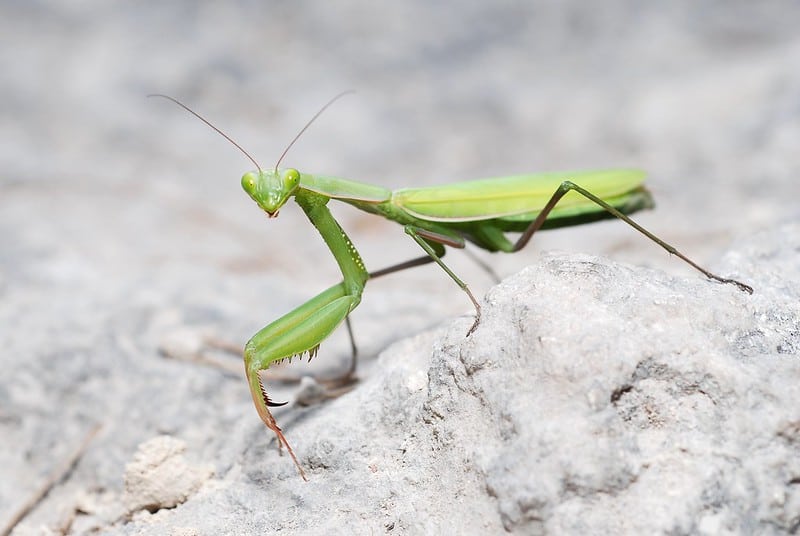
European Mantis Care Sheet
| Name of species | Mantis religiosa |
| Family | Mantidae |
| Common name | European Mantis |
| Category | Mantis |
| Native location | Europe |
| Temperature | 68°F to 78°F |
| Humidity | 40% to 65% |
| Size | Females: 2.75 to 3.5 inches / Males: 2 to 2.5 inches |
| Diet | Insects: Moths, crickets, roaches, grasshoppers etc |
| Lifespan | Females: 11 to 12 months / Males: 7 to 8 months |
| Experience level | Beginner |
European Mantis Overview
The European Mantis, or Mantis religiosa, is native to Europe but was introduced in the 1600s in the United States as a form of pest control. It’s since thrived in the United States and has even become the state insect of Connecticut.
This Mantid species is interesting because it’s seen as the archetype of what it means to be a mantis. When people think of the words “praying mantis”, this species is often what they envision.
The European Mantis might not look as impressive as some of the other mantid species, such as the Orchid or Spiny Flower Mantis, but it’s a remarkable creature nonetheless that can be a very interesting pet. They’re excellent, active hunters that have a very strong feeding response.
Appearance & Variations
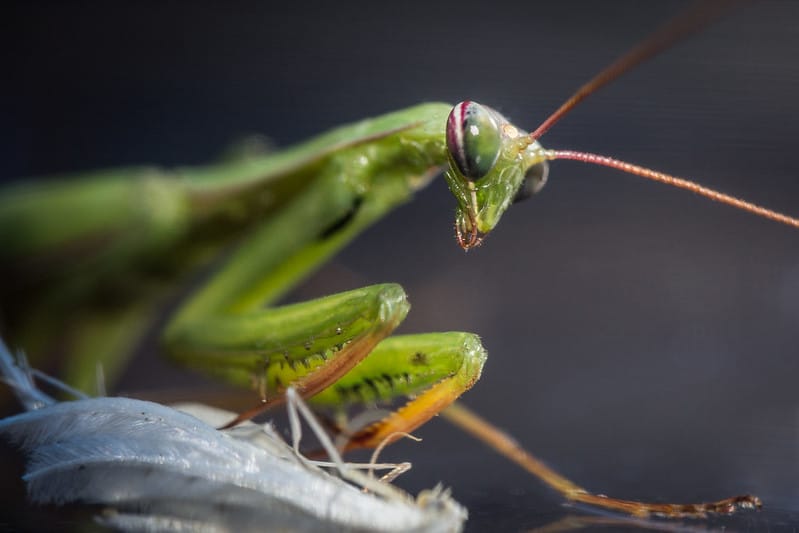
The European Mantis is characterized by its green or brown color. In fact, they’re even capable of switching between these colors. They’re not able to change color instantaneously like a chameleon can, but they’re capable of changing colors between molts.
It’s not entirely certain how the mechanism behind this color change works, and there are many hypotheses behind the mechanism behind it. However, it is believed that in the wild their color-changing ability is an essential part of their camouflage.
In captivity, their color depends on the temperature, light, and humidity of their habitat.
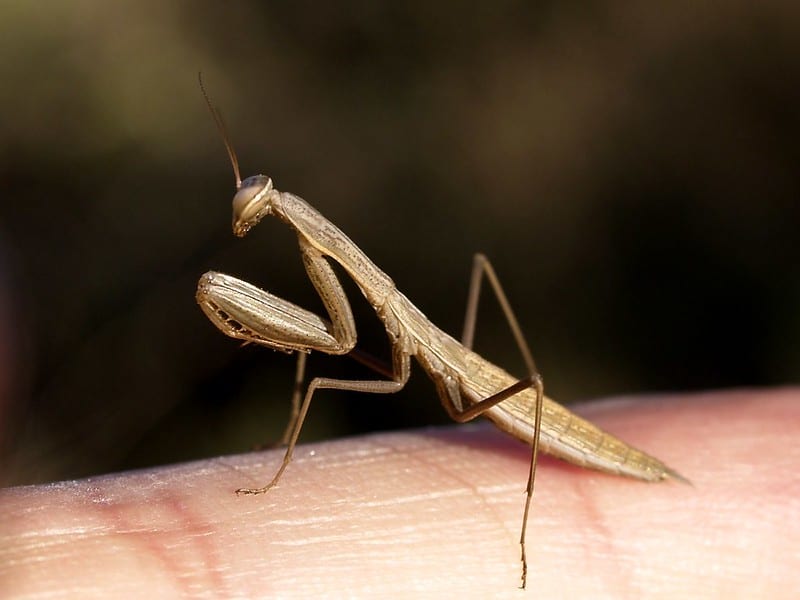
You can easily recognize this species by taking a look at the pattern on the inside of their front legs. If you take a close look, you’ll see a black spot with a white circle in the middle of this. This pattern resembles the eyes of a predator and is used to help deter threats.
The European Mantis is dimorphic with males being smaller than females. Females typically grow to a size of 2.75 to 3.5 inches while males are typically between 2.3 and 2.5 inches. In addition, females are often much bulkier and heavier while males are slender. Males also have longer wings and longer antennae. While these characteristics can help determine whether a mantis is male or female the most accurate way to determine this is by looking at their abdominal segments: males have 8, and females have 6.
This species also has the characteristic triangular mantid head with large compound eyes. They also have strong raptorial legs that they use to catch prey.
Temperament & Behavior
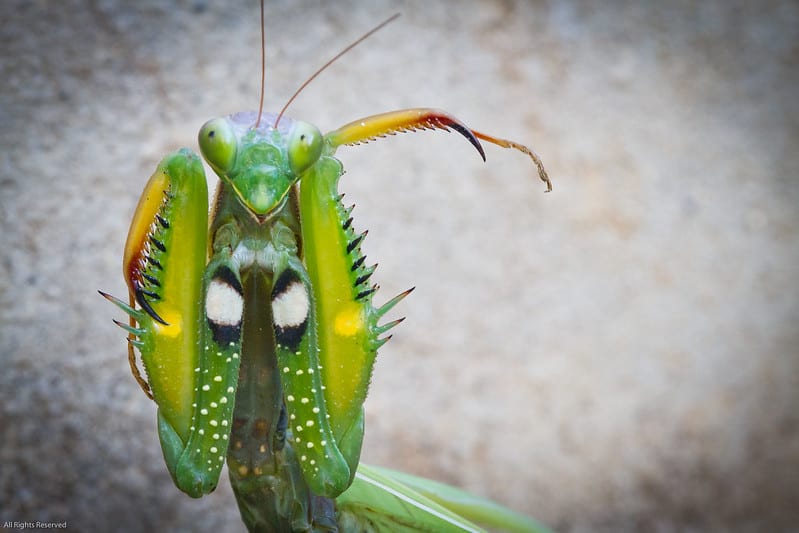
The European Mantis is generally quite docile towards humans but very aggressive towards its prey. You can handle them, but you do have to be careful. While the mantis will not pose a threat to you, you can definitely pose a threat to them.
If they feel threatened, they’ll typically try to flee or strike a threat posture. When they show a threat posture it’s best to leave them alone to avoid stressing them out.
While mantises might look intimidating, they do not pose a threat to humans. They are capable of using their mandibles to bite you, but it’s very rare and it’s not threatening if you do get bitten. You might feel a pinch, but European Mantises are not venomous and their bites are not dangerous at all.
Typically though, they’ll try to avoid confrontation with someone as big as a human.
Price
The European Mantis is a widespread and common species. As a result, they’re quite cheap to buy. You can buy a whole ootheca (egg sac) for as little as $15 which contains anywhere from 100 to 200 eggs that will hatch into nymphs.
Buying a single Mantis religiosa is also possible and typically costs only a few dollars, though not many online breeders seem to sell them.
Caring for a European Mantis
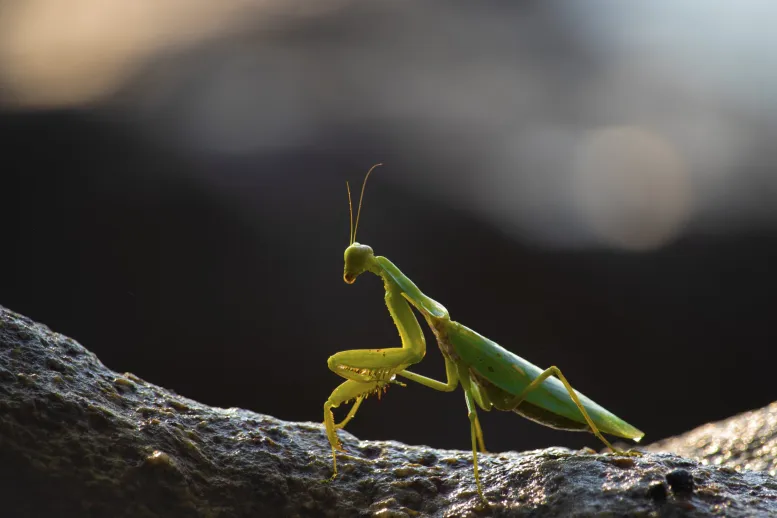
The European Mantis is surprisingly easy to care for. All they really need is a good enclosure with adequate temperature and humidity levels and a diet that fits their needs.
Here’s what your mantis needs to thrive!
Enclosure setup
The enclosure that you house your European Mantis in should be at least 3 times as long as their body length.
So, if you have a female mantis that’s 3 inches long, their enclosure should be at least 9 inches in length. It should also be at least twice as wide as their body length, so for the same 3-inch mantis, they’d need an enclosure that’s 6 inches wide. It also needs to be tall enough to allow your mantis to climb on sticks and hang upside down.
Keep in mind that the dimensions mentioned above are a minimum. A slightly bigger enclosure is always nice, but it shouldn’t be too big either as that can make it difficult for your mantis to hunt.
Their enclosure should be decorated with plenty of sticks, twigs, fake plants, and hiding places. You can choose to create a bioactive enclosure, with living plants and other small insects that take care of mold, but this can be difficult for beginners and is time-consuming.
A bioactive enclosure is nice, but you can also choose to simply place some dead twigs and branches in their enclosure. As long as they have a place where they can hang upside down to molt and plenty of hiding spaces they will be content.
Substrate
You can use many different materials for substrate as long as it doesn’t mold easily and is absorbent. The best material to choose is coconut fiber as it’s great at retaining moisture. Vermiculite, potting soil, or a mixture of the previous three is also an option.
The European Mantis will not burrow, so a layer of about an inch thick is more than enough.
Temperature & humidity
The optimal temperature for the European Mantis is around 73°F to 78°F. Luckily, this is room temperature for most people which makes getting the temperature right quite easy. At night, the temperature can drop a bit lower than that but should not fall too low.
As for humidity, the best relative humidity level for this species is between 40 and 65%. You can increase the humidity level in their enclosure by misting and choosing a substrate that’s moisture-absorbent. Since the European Mantis doesn’t require very hot temperatures it’s easier to reach their required relative humidity levels than for some other species that require warmer weather.
Ventilation is also important to avoid the growth of mold and bacteria.
Watering
The European Mantis does not need a water bowl to drink from. They will get their hydration from their food and from the droplets that form as a result of the spraying. Because of this, it’s important that you spray their enclosure 2 to 3 times a week. This not only helps keep the humidity up but also gives your mantis the opportunity to drink.
Diet & feeding your European Mantis
The European Mantis is a fierce predator that has a strong feeding response. Their appetite tends to increase in warmer temperatures, which also leads to faster growth and development.
They’re carnivorous ambush predators that prey on a variety of insects in the wild such as crickets, cockroaches, and grasshoppers.
In captivity, most owners feed them a diet that consists of a variety of different feeder insects such as blowflies, mealworms, locusts, or blue bottle flies. Blue bottle flies are by far the most popular feeder insects and are highly recommended.
It should be noted that some owners feed them crickets, while others recommend strongly against ever feeding crickets to a mantis.
What they eat also depends on their size. Small nymphs should of course eat much smaller insects than adults. For L1 to L3 nymphs stick to fruit flies. As they get bigger, they can start feeding on house flies, blue bottle flies, and other larger feeder insects.
Molting
Like all mantids, the European Mantis will have many molts in its life. Molting is the process of shedding the exoskeleton so that they can keep growing. You will notice that your mantis will refuse to eat right before a molt. This is nothing to worry about and is very normal.
When it’s time to molt they’ll hang motionlessly upside down. Do not disturb them during this time as a failed molt can have disastrous consequences such as lost limbs or even death.
Once the molt has completed, refrain from feeding them for 24 hours to give their new exoskeleton time to harden. Also, do not handle them for at least 48 hours after a molt since they’re extremely fragile at this point.
Communal living
The European Mantis is a territorial species that’s aggressive towards members of its species. As a result, you cannot house them communally. In the wild, they only meet when it’s time to mate, and even that can end with the female eating the male.
Never attempt to house more than European Mantis in a single enclosure as this will lead to cannibalism. If you want a communal species, check out the Devil’s Flower Mantis or the Ghost Mantis instead.
Health & Lifespan
The European Mantis is hardy and does not get sick easily. In captivity, not much prevents them from reaching their full lifespan if you care for them properly. Females typically have a maximum lifespan of 11 to 12 months while males live shorter at around 7 to 8 months.
To keep them in good shape, it’s important that you remove uneaten food and have adequate ventilation. This will help prevent the growth of mold. You should also be very careful when handling them since they’re small and fragile animals.
In addition, it’s important that you keep the humidity level up. This will not only keep them comfortable, but also allows them to drink and molt more easily.
Lastly, it’s important to feed high-quality, captive-bred food. Wild-caught insects can contain parasites that can spread to your mantis.
Breeding a European Mantis
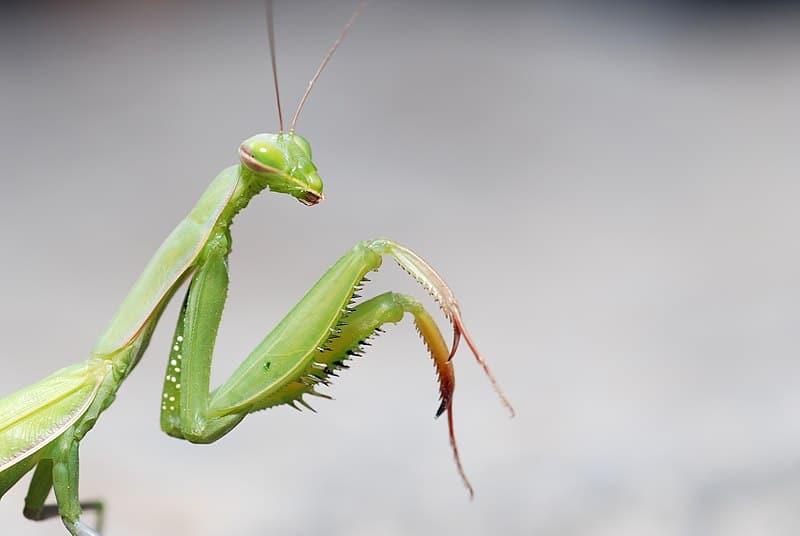
The Mantis religiosa will be ready to breed 2 to 4 weeks after reaching adulthood. In order to breed them you’ll need to have access to a male and a female. To identify males and females, look at their abdominal segments, males will have more segments than females.
Before introducing them, make sure that the female is well-fed, ideally, she should be eating during the introduction. This will help prevent aggression towards the male. If you notice that the female attacks the male during the mating attempt seperate them.
If everything goes smoothly, the mating process can take a few hours. Remove the male after the mating to prevent him being eaten alive.
The female will lay an egg sac (ootheca) after the mating process. This egg sac should be placed in a cold environment for 6 to 8 weeks. This process is called a diapause and is necessary to ensure that the nymphs that hatch will be strong and healthy.
European Mantis Fun Facts
- There are many subspecies of the Mantis religiosa that are found all over the world.
- The Mantis religiosa was first described in 1758.
- You should not extract this species from the wild. Even though it’s rated by the IUCN as “least concern”, it is not supposed to be caught.
- The name “praying mantis” comes from the distinctive posture of the first pair of legs which make them look like they’re praying.
Final words
The European Mantis is the archetypical Praying Mantis. They’re an extremely cool insect that have become beloved pets of many people. They’re surprisingly easy to care for and cheap to buy, which makes them an excellent introduction to the mantis keeping hobby. Even for more experienced keeperes this species still has a lot to offer!
Is after reading this and seeing the pictures you’ve decided that this species is not for you you might be interested in checking out the Orchid or Spiny Flower Mantis instead.
- How Long Do American Eskimo Dogs Live? Important Factors and Care Tips - September 29, 2023
- Do American Bulldogs Need Grooming? Essential Tips and Care Guidelines - September 29, 2023
- Do Bengal Cats Enjoy Playing? Essential Tips for Keeping Them Active - September 29, 2023